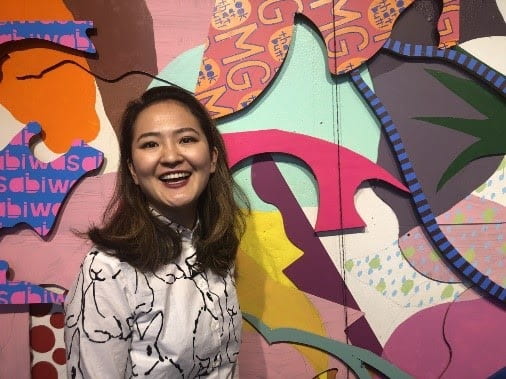This week we will be spotlight the work of Yurie Hayashi, a second-year student in the Master of Fine Arts program. Hayashi is from Japan. She received a BA in International Studies from a Japanese University before moving to the United States to pursue her interest in art. After graduating with her first degree, Hayashi completed a degree in painting at Edinboro University of Pennsylvania. She minored in art history and metal/jewelry-making.
“Learning art was what I wanted to do right after high school,” Hayashi says. “With Asian parents, it is very difficult to convince them to support what you want to do. It is considered respectful to follow parents’ wills. Mine wanted me to simply get a job, eventually, get married, and have a baby, I disagreed. Instead, I secretly applied to only one undergrad program. I was going to give up if it did not go through, but luckily enough, I got into an art program.”

Hayashi is particularly interested in the illusion of depth and flatness in her paintings. “What do I gain from a painting in two dimensions? Paintings are traditionally in two dimensions,” She says. “Many painters from the past, including Picasso, made a sculpture and then use the sculpture to paint a trompe l’oeil (trick of eyes) painting on a flat surface. What do I gain from a painting in three dimensions? It is exciting to look and observe when a painting has actual holes and spaces to examine. I spend an almost equal amount of time making my maquette and painting but in different moods.”
She finds inspiration for her art in everyday things. “Inspiration could come from conversation, music, a daily walk, nature, books, a movie, or pretty much anything,” Hayashi says. “I often have images in my head how to cast the image to the physical world from my head. I think that is the most difficult thing for me, a vague image in my head to a visible conclusive structure.”
Some of Hayashi’s favorite artists are Picasso, Matisse, and David Hockney. Her recent favorite is Erin Okeefe. “She is a photographer who takes pictures of colorful still-lifes and manipulates the image to have distorted spaces,” Hayashi says of Okeefe. “We both are manipulating the three-dimensional objects in space into two-dimensional something else. She does it with photography; I do it with painting.”

“This [the painting above] is one of the biggest pieces, 80 inches by 42 inches, I am currently working on,” Hayashi explains. “I will use this big structure of maquette to paint the structure on canvas. The wall structure was made of plywood and masonite which were colored with oil paints, house paints, and acrylic paints.”
“Maquettes are usually rough draft of casting what I have in my head, in a way, they are vomit. Some pieces include a degree of appropriation and re-contextualization of cultural artifacts (advertising, language. customs, etc.). Often, then I find humor in the original context. When I start to paint the maquette onto canvas (with oil paints), It feels as if I were breaking down the vomit feelings and putting them back, digesting and understanding the contexts inside of me. The word choices [in the painting] are from religions to cultural norms, conversations from daily lives, and cultural jokes. Especially on this one, I have ‘OMG look at that butt, wabisabi wasabi and sushi, ninja, and ‘where are you originally from? You have an accent.’. As a foreigner, we tend to learn certain words quicker, such as slang. And for me, using slag makes me feel as if I belong here or being part of the community.”
When asked what part of her work she is most proud of Hayashi said, “I asked this question to my studio mate, and she said, “the most admirable thing about your work is that you are always being yourself and be honest to show your own opinions and feelings through artwork.”
Hayashi also teaches art. “I am currently teaching two of foundation drawing classes, and that makes me realize it is interesting to teach and involve with students. I learn so much from them to be a better teacher and a better human. I would love to teach in the future, but I definitely want to keep working with my paintings. I am curious to see how my work could evolve by working three-dimensional, such as working with clay, furniture design, or fabrics.” She says.
When she isn’t painting or teaching one of her favorite hobbies is traveling. “I miss traveling right now,” She says. “I have been to Australia, Spain, France, Italy, Korea, Singapore, and Malaysia. I only speak Japanese and English, so I try to learn the language wherever I travel, at least to say, ‘thank you’ and ‘delicious’ in their languages.” Hayashi plans to graduate in 2022.
You can find out more about Yurie and her work by following her on Instagram at:
@yurie.h.1221
